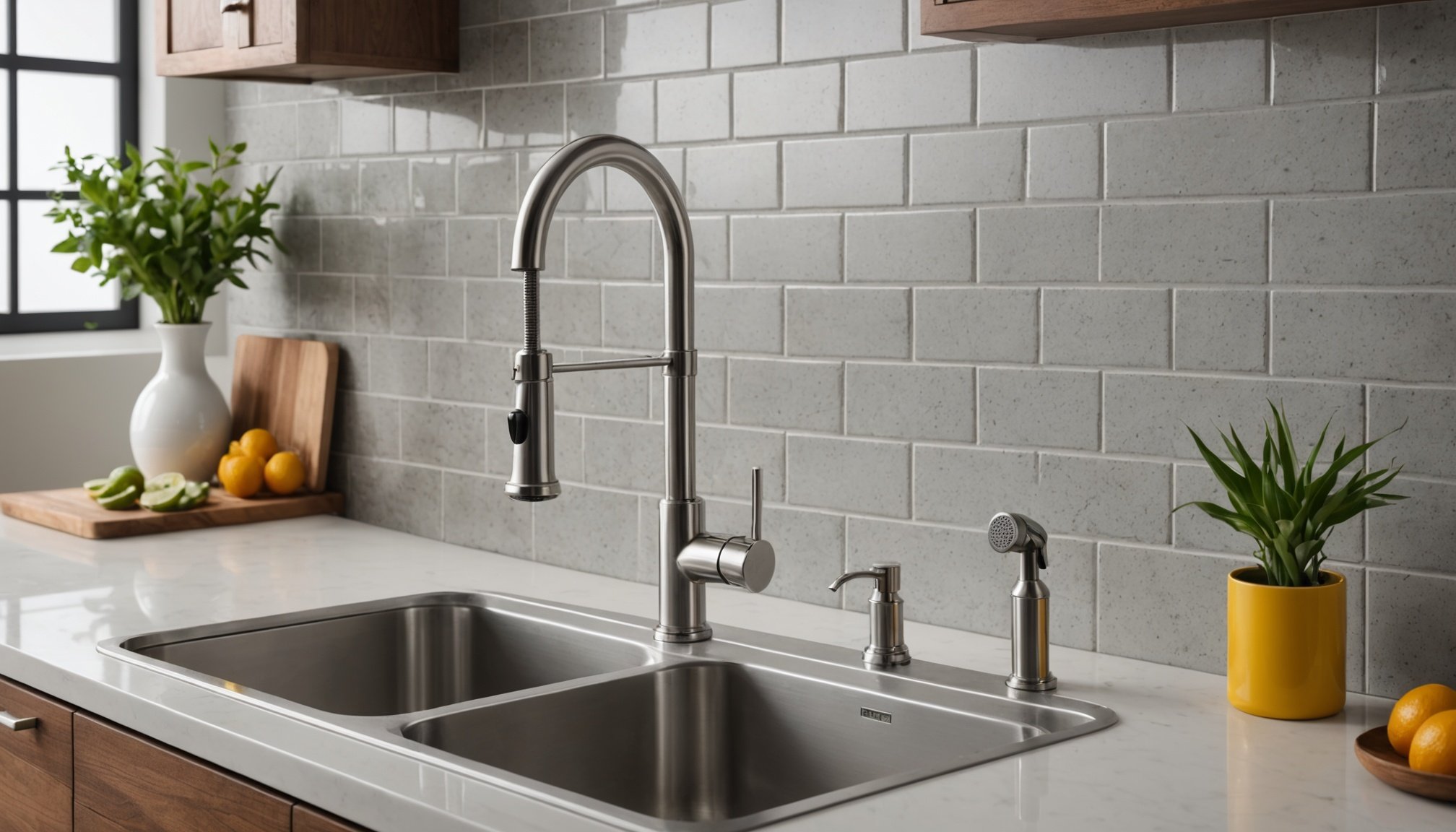Understanding Kitchen Taps
Choosing the right kitchen taps can transform your kitchen both aesthetically and functionally. There are several types available, catering to different tastes and needs. Traditional taps often feature a more classic design, fitting well in rustic or vintage-inspired kitchens. On the other hand, modern taps are sleek, offering minimalist designs that align with contemporary styles.
A key player in most kitchens today is the mixer tap. Combining hot and cold water streams into a single flow, this type is highly valued for its convenience. Meanwhile, pull-down features cater to those seeking flexibility and ease, with their extendable hoses simplifying tasks like washing vegetables or cleaning.
Also to see : Eco-Conscious Coffee Maker Guide: A Comprehensive UK Handbook for Sustainable Living
When selecting kitchen taps, consider the materials and finishes available. Stainless steel is renowned for its durability and resistance to corrosion, while brass offers a premium feel and long-lasting performance. Other finishes such as chrome or brushed metal can match various kitchen themes, adding both style and durability.
Incorporating the suitable kitchen taps ensures a balance between style and practicality. Understanding your kitchen’s design, along with the specific functionality required, is paramount when making your choice.
Also read : The Essential UK Family Guide: How to Select the Perfect Refrigerator Size for Your Growing Needs
Water Conservation Features in Kitchen Taps
When considering water-saving taps, it’s essential to understand flow rate regulations in the UK, which dictate the maximum water output to aid in conservation. These standards ensure that taps limit the flow rate, effectively reducing water consumption in households.
At the heart of eco-friendly tap design are aerators and flow restrictors. An aerator mixes air with water to produce a steadier flow while using less water, achieving a gentle efficiency. Flow restrictors limit the water volume, maintaining adequate pressure without unnecessary waste. These features are subtle yet powerful in conserving water.
Modern taps increasingly incorporate eco-friendly technologies. Some models adjust flow according to use, while others use sensors for touchless operation, minimizing water waste remarkably. This technology is not only practical but also aligns with smart home trends.
In conclusion, selecting taps with robust water conservation features offers significant benefits. These taps not only support environmentally sustainable practices but can also help reduce water bills for households. Consumers can look for specific eco-certifications or ratings when purchasing taps to ensure compliance with established water-saving benchmarks.
Installation Considerations for Kitchen Taps
Deciding between DIY and professional installation for your kitchen taps depends on your comfort level with plumbing tasks. DIY installation can be cost-effective, especially if you possess basic plumbing knowledge. However, it requires specific tools such as adjustable wrenches, pliers, and pipe sealant. Furthermore, you should ensure you have the correct tap connectors to match the plumbing setup in your kitchen.
Professional installation, while more expensive, guarantees expertise, especially crucial in complex installations involving mixers or pull-down features. An expert can handle unexpected issues and ensure compliance with local standards, something worth considering in older UK homes where original plumbing might present unique challenges.
Plumbing considerations are equally important; for instance, UK homes typically use different piping systems, including copper or plastic pipes, which can impact the installation process. It’s essential to verify that the new taps are compatible with the existing plumbing infrastructure, particularly regarding pressure limits to ensure optimal functionality.
In summary, selecting the right installation method hinges on your skill, budget, and the complexity involved. Evaluating these factors can help ensure a hassle-free kitchen tap installation that enhances both functionality and style.
Popular Kitchen Tap Models and Comparisons
When considering the best UK kitchen taps, several high-efficiency models stand out due to their water-saving features and stylish designs. These models blend eco-efficiency with aesthetics, providing both functionality and elegance in modern kitchens.
High-efficiency Models
High-efficiency taps use advanced mechanisms like aerators and flow restrictors to minimise water waste. Brands such as Grohe and Moen offer models that excel in water conservation, often featuring touchless technology for added convenience. These taps typically meet rigorous eco-certifications, ensuring their performance aligns with environmental standards.
Stylish Design Options
Styling options are plentiful, with many taps available in sleek finishes such as matte black or brushed nickel. These finishes suit contemporary kitchen aesthetics. Some popular designs include those with pull-down spouts, allowing for versatile water flow control and easy cleaning. Brands like Franke and Blanco provide options that marry form with function, making them top choices for home renovators.
Budget-friendly Solutions
For cost-conscious consumers, brands such as Bristan offer budget-friendly alternatives that do not skimp on quality. These taps provide reliable performance and durability, often coming with neat features like easy installation systems. Despite the lower price point, they maintain a satisfactory balance between affordability and efficiency.
Smart Strategies for Reducing Water Usage
Reducing water usage in the kitchen is not just about choosing the right taps but employing smart strategies to maximise efficiency. Adopting best practices in your tap usage is a simple yet effective method. Ensuring taps are fully off when not in use and rinsing fruits and vegetables in a bowl rather than under a running tap can significantly cut down water consumption.
Innovative gadgets and devices can greatly assist in monitoring and managing water use. Devices like smart flow meters can track water usage patterns, providing data that can help in spotting wasteful habits and offering insights for improvement. Moreover, installing smart devices that notify you of leaks or unusual flows can prevent excessive water loss.
There’s compelling evidence in various case studies showcasing the impact of water conservation in UK homes. Households implementing these strategies have reported substantial reductions in their water bills and consumption levels, a testament to the effectiveness of integrating such technologies and methods. By regularly reviewing water usage data and adjusting habits accordingly, homeowners can significantly contribute to conservation efforts while enjoying cost savings.
Relevant UK Regulations and Standards
The installation of kitchen taps in the UK is governed by specific plumbing regulations that ensure safety and efficiency. These UK plumbing regulations dictate that all installations must comply with the rules laid out in documents such as the Water Supply (Water Fittings) Regulations 1999. It is essential to adhere to these standards to prevent issues like water contamination and to guarantee efficient water usage.
Compliance with Water Efficiency Standards
To ensure your kitchen taps meet water efficiency standards, consider taps that incorporate water-saving technologies like aerators or flow restrictors. Such features align with the UK government’s commitment to reducing household water consumption. Compliance not only promotes environmental sustainability but also helps in reducing water bills, creating a win-win scenario for homeowners.
Resources for Checking Regulatory Updates
Homeowners and professionals in the plumbing sector can access a variety of resources to stay informed of any regulatory updates. The Water Regulations Advisory Scheme (WRAS) is an invaluable resource, offering guidance and updates on compliance requirements. Regularly checking portals and updates from WRAS ensures that your kitchen tap installations remain current with evolving standards, thereby upholding legality and environmental responsibility.

